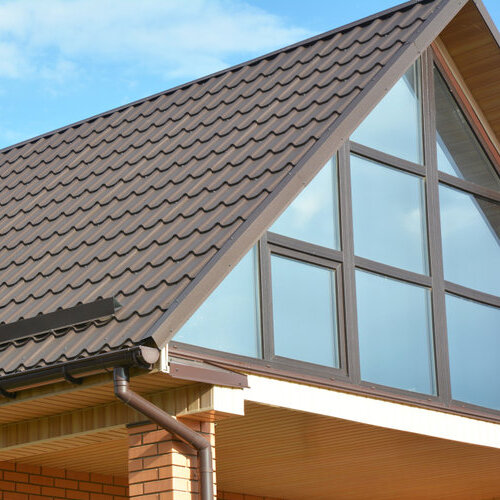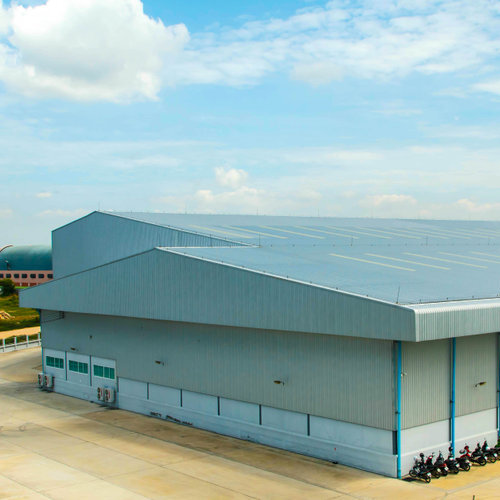
The Increasing Popularity of Metal Roofing
There was a time that you could only find a metal roof on barns. But today, metal roof installation is happening on commercial structures and residential structures of all sizes. Commercial metal roofing isn’t all that new, and if you look around some neighborhoods, you may find that metal roof installations have been taking place for a while now.
Why metal roofing?
There are a few reasons many businesses and homeowners have gone with metal roof installation in recent years:
- Longer lifespan
- Water, snow resistant
- Fire resistant
- Insect resistant
- Rot resistant
- Mildew resistant
- Longer warranty – up to 50 years
Metal roofing sheets are lightweight, making a metal roof installation cheaper and faster. Available in steel roofing and aluminum roofing, the gauge of metal roofing is lighter than clay tiles by 15 times and 18 times lighter than concrete shingles.
Metal roofing also has radiant barrier reflectivity that will protect the structure from radiant heat. To have a radiant barrier with other roofing materials, special insulation must be added, making the cost of metal roof installation cheaper yet again.
What are the different types of metal roofs?
There are proven advantages to getting metal roof installation on a home as a long-term investment. The durability and sturdiness metal roofing offers, as well as the longer lifespan and low maintenance needs, are definitely pluses. With up to an 80-year lifespan, a metal roof installation will likely be the last roof installation a homeowner will need.
Metals commonly being installed on homes today include:
- Aluminum
- Copper
- Corrugated
- Metal Tile
- Metal Slate
- Standing Seam
- Steel
- Tin
- Zinc
For commercial structures, metal roof installation is a popular choice mainly because of the cost and durability. Like homeowners, a commercial structure owner will probably never have to worry with another roof installation once they have a metal roof installation.
For commercial structures getting metal roof installation, aluminum or steel in a standing seam style is the most popular choice. Steel is color-coated galvanized or galvalume steel, matching the building’s architecture. With a steel metal roof installation, some building owners choose raw metal panels and let them weather naturally.
Can metal roofing go over old material?
Typically, because metal roofing material is of a lighter weight, the additional weight on an existing roof isn’t a problem. For commercial or residential structures, it is recommended to verify building codes when shopping for metal roof installation. The roofing contractor will probably do the same thing, but you’ll know ahead of time and not be surprised.
With a commercial or residential metal roof installation, you need to verify with the roofing contractor that there is ample ventilation for the existing roof. While the metal roofing won’t be as much of a concern, the moisture build-up from a lack of ventilation can be a problem for the rest of the structure.
Which metal roofing is best?
A metal roof installation on your home or business is an investment for the long-term, whether you will live there or place the up house for sale. Any potential buyer will appreciate the long service life the roof will give them and the curb appeal you’ll enjoy is endless. This is a durable, weather-resistant addition that will help reduce your utility expenses. Aluminum, copper, Galvalume, stainless steel, or zinc are all great choices. Your budget will be key to the decision, with copper being the most expensive. The architectural style of your home will be a factor in your choice as well.
How energy efficient is a metal roof?
Because metal roofing reflects heat up and away from the structure, these roofs have been declared a highly energy-efficient roofing choice. A high-quality metal roof installation can save homeowners as much as 40% in energy expenses.
For a commercial structure, a metal roof installation coated with a light color that reflects heat can be a tremendous energy saver, all without the need for added insulation. For commercial structures in colder regions, a dark color coated metal roof installation can help keep a building warmer with less help from the heating system.

Topping Things Off With Additional Information
There are a few other things to bear in mind when it comes to metal roofing.
- A metal roof doesn’t have to look like a metal roof – a big plus for residential architects. They can look like shingles and still give you the durability of a metal roof installation.
- Metal roofing is no longer for old barns in the country or high-end real estate.
- Metal roofing isn’t going to be any louder than other roofing materials when installed correctly over a substrate.
- Metal roofing does not attract lighting and if hit by lighting, isn’t a combustible material.
- Insurance companies tend to favor metal roofing with some discounts.
- Metal roofing is good for low sloped roofing as well as pitched roofing.
Downsides to a metal roofing installation include the expense, though this is offset by the longevity they offer. Another downside is hail can damage certain types of metal roofing like aluminum or copper. A structure in an area prone to hailstones should go with a steel metal roof. Keeping this all in mind can help you make a great decision when choosing your new roof. If you’re ready for more information, contact the Texas Cool Roofing & Waterproofing team by calling 512-617-7335 today.
